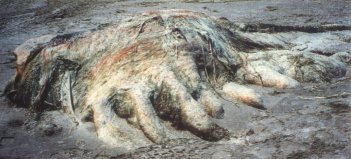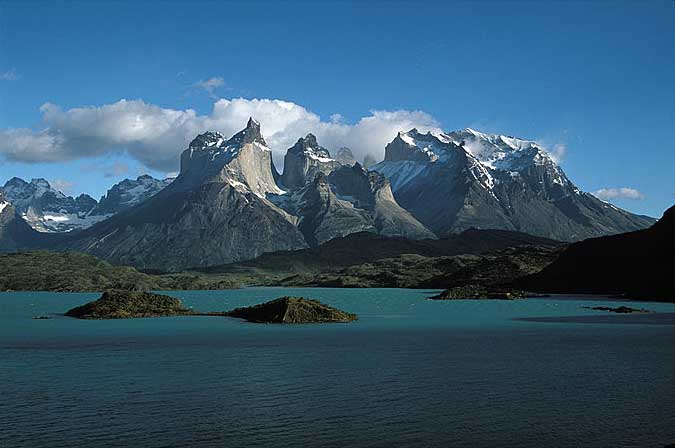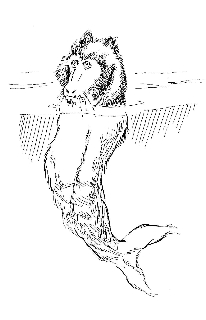Fulk Lake
Churubusco, Indiana, United States
|
An Oscar float from a long ago Turtle Days parade. |
Oscar the Turtle is the reason Churubsuco, Indiana is called Turtle Town USA. According to reports, Oscar, otherwise known as the Beast of Busco, is a gigantic snapping turtle with a shell as large as a car, a neck the size of a stovepipe and a head as big as a child's.
Numerous reliable eyewitness reports, including mass sightings, lend credence to the story. The farmer who owned the land containing the lake the beast supposedly called home conducted numerous searches for the gigantic turtle in 1949. Although there were several close encounters, these searches yielded no tangible evidence in the end.
The Sightings
In 1898, farmer Oscar Fulk claimed that a huge turtle was living in the small lake on his farm. Of course no one took him seriously--for now. A subsequent sighting took place in 1914, again to little fanfare.
But on July 27, 1948, locals Ora Blue and Charlie (or Charley) Wilson told Gale Harris, now the owner of the property, that a gigantic turtle had surfaced near their boat while they were out fishing on the lake.
Its body was as big as their rowboat and its head as big as a child's. According to some sources, the men claimed that the turtle had stolen their fishing poles. Churubusco resident and turtle expert Rusty Reed talked with Blue and dismissed the story as a hoax.
"Charley Wilson was known to tell tall tales and Gale Harris was known to believe anything," Reed says.
Despite this, the enormous turtle quickly became a celebrity. The local newspaper reported it, and Harris had a sighting of his own. Some began to say that the turtle had former owner Oscar Fulk's initials carved into its shell. The newspapers in Fort Wayne, poking fun at the townspeople for believing in such a creature, nicknamed the creature "Oscar" and "The Beast of Busco." The names stuck.
In 1949 Harris spotted the creature again. Desperate to prove he wasn't a lunatic, he decided to conduct a monster hunt and finally lure the great turtle out of hiding.
|
An actual turtle in Fulk Lake. |
The Hunt
News of the hunt spread far and wide, even reaching newspapers in Europe, according to the Churubusco Chamber of Commerce.
Harris and local garage mechanic Kenneth Leitch began constructing traps to capture the beast, and Harris reportedly built a periscope to try to spot the turtle from the surface.
On the first day of the hunt, in early March of 1949, Harris and the crowd he had drawn actually penned the beast in about 10 feet of water with a trap of stakes and chicken wire. Footage that has now vanished showed turtle swimming just below surface. But Oscar the Turtle somehow managed to escape.
On March 7 the newspaper in Columbia City reported the ongoing search. The next day, reporters from Fort Wayne showed up. A day later, updates on the great monster hunt were reported across the nation.
By March 12, 200 people gathered at Harris' farm to watch the hunt. The crowd soon ballooned out of control. Twenty years short of Woodstock, bumper-to-bumper traffic wound around Harris' farm and planes flew overhead trying to spot the creature from the air. In two days, 3,000 curious citizens, reporters, professional trappers, zoo officials, and deep-sea divers had swarmed to the farm.
Here is a reprinted news article from that point in the search.
|
A giant concrete turtle statue in Charabusco. |
On March 18th, Harris got hold of a complete dive suit, and diver Woodrow Rigsby tried to walk the bottom of the lake, but the helmet began to leak and Rigsby called off the operation. Another diver, Walter Johnson, tried his hand at the search as well but gave up after two-and-a-half hours because he kept sinking chest-deep into the muck.
In April, two men from Indianapolis claimed to have finally caught the giant turtle. This, however, turned out to be a hoax; the men had simply bought a sea turtle to try to trick the public. According to Unknown Explorers, this hoax is what sparked the idea to lure Oscar out of the lake using a female sea turtle. With no giant turtle to marvel at, the public's interest had dwindled by May. Harris kept at it, though, at one point using dynamite charges to try to scare the monster to the surface.
Finally, in September, Harris attached water pumps to his tractor and began to drain his lake, drawing some crowds back. The crowds began to grow again, and Harris charged a fee this time to make up for the cost of the pumping operation and all the crops trampled by crowds. On October 13, as 200 spectators looked on, the Beast of Busco reportedly surfaced in an attempt to catch a duck being used as a lure. Soon after, however, the muck at the bottom of the lake wore out the pump and broke Harris' tractor. Never one to quit, Harris brought in a crane to dredge the lake. But even when the lake had been drained to a depth of five feet, there was no giant turtle in sight. The disappointed locals speculated that he had migrated to another lake or river through underground channels.
In December Harris came down with appendicitis and when he had recovered sufficiently to resume the search, rain had mostly refilled the lake. The next year, dejected and out of money, he sold his farm and his turtle traps.
There have been no reported sightings of Oscar since then.
|
Rusty Reed and Steve Cook
bring Crunch, a 120-pound
alligator snapping turtle, to
Turtle Days in 1993. |
Jim Guiff, the nephew of Oscar Fulk, wasn't surprised that Harris didn't find the turtle.
“I was always suspicious about the turtle being as big as he was,” he says. “I used to hunt for snapping turtles when I was a kid, and I never saw them that big. I never disputed
them, though, because maybe I was wrong.”
Guiff does believe Harris believed in the turtle because of the amount of money he lost looking for it. Rusty Reed agrees.
“Gale Harris lost everything over trying to prove that he saw that turtle,” he says. “Does a person get so caught up in a lie that he can’t turn back, or did he really see it?”
An Explanation?
Reed believes the Beast of Busco could have been an alligator snapping turtle that somehow made its way 200 miles north of its natural habitat in southern Indiana's rivers (they're rare in northern Indiana). Alligator snapping turtles are one of the largest freshwater turtles in the world, having been known to grow to two-and-a-half feet. The largest confirmed specimen weighed 249 lb (113 kg) and an unconfirmed weight put the heaviest at 403 lb (183 kg). They can live more than 100 years, allowing the long span of sightings in Churubusco.
In the late 1800s and early 1900s, according to Reed, travelling salesmen from southern Indiana sometimes took young alligator snapping turtles with them when they went north as an emergency food source. The salesmen might sell, give away, or release the turtles. Reed says that if Oscar ever did exist, he probably either suffocated under the collapsing mud when the lake was drained or hid in a puddle until the water came back.
Still Swimming
Guiff remembers Gale Harris as an honest, humble man and remembers his uncle Oscar Fulk as a "character." He remembers the great turtle hunt well, and recalls one night when a man, perhaps Harris, steering a boat toward a trap while about 12 men stood watching. Someone shone a light onto the trap, but all that was visible was murky water.
|
Amusement rides are part of the attraction
at Turtle Days. |
Aside from in Guiff's memory, the Beast of Busco lives on in Churubusco's annual Turtle Days festival in June. The festivities at Turtle Days celebrate the monster with live bands, raffle drawings, rides, turtle races, and a parade.
In nearby Decatur, Indiana, a restaurant wall displays a yard-long turtle shell which the owners claim is Oscar's. Check it out.
|
Resident Larry Kenner snapped this photo of the animal. |
Indianans seem to have an odd habit of spotting large creatures in small lakes. During the summer of 2010, the residents of Wayne, Indiana began seeing something strange in the lake at Lakeside Park. The creature, according to one witness, had “a snake’s tail. It was really long and really big in the middle and it had fish scales.” Though many who heard the tales thought the creature was just an escaped carp, witnesses claimed that the creature was bigger than a snake and seemed to slither through the water. One witness said she had seen the creature acting strangely, as though it was strangling a fish.
MORE ON THE BEAST OF BUSCO:












